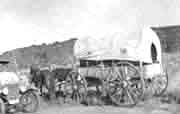
Though our family lived in San Francisco, we were not without some experience with country life. My Uncle Jeff Salinger had a ranch up at Hopland, California, and Mom would take us, the four children, there for summer vacation. There was no electricity on the ranch. There were kerosene lamps and a big wood-burning stove. We learned a great deal there, and, naturally, so did our mother.
One story was of our brother Charlie. After Uncle Jeff and his helpers had separated the lambs and the ewes, an all day job, Charlie went for a walk and left the gate open. This was only one little thing we learned (CLOSE THE GATES) out of many.
In those days, San Francisco was a small town, many empty lots and well-defined borders. There were three or four farms within the city limits. When you went to San Bruno, a few miles south of the City, you were way out in the country. Stanford was truly "The Farm". The idea of country and the problems of living in the country were not as remote as they are to the average San Franciscan of today. Many streets had cobblestones, so the horses could get footing with their hooves.
Mom and Pop were hikers and generally investigators of the wilds. They climbed Mt. Tamalpais frequently, which is not very wild, but which got them into the country. In those days, it really was country. They went to the Sierra Nevadas. On one occasion my mother's three brothers and my father went on a hiking trip there. They came to the base of Mt. Whitney. The three brothers started up the hill next morning early, leaving Pop to read all day. That night they returned, having made it to the top, tired and hungry, and found Pop reading. No dinner, no fire, no nothing. For a little while, Pop was not the most popular of the group.
From the City to the Great Southwest, then, was not such a tremendous leap as it would be today. Such a simple thing as changing a tire, which meant taking off the rim, using a tire iron to get the tire off the wheel, taking out the tube, finding and patching the leak, putting it all back together, and then pumping up the tire, was usual to city folk.
These experiences and many similar ones helped my parents understand the Indian Country when they went down to the Great Southwest in 1922 for the first time. This in turn provided them with a headstart in dealing with the Indians.
Before we go on, I would like to set one more thing before you. Mom and Pop started their adventure in these things in 1922. Arizona and New Mexico were the wild west. I was privileged to be there occasionally from 1926 on. I am now standing before you, in one of the most sophisticated, advanced cities in the world. My point is that we are still very, very close to the wild west.
Cowboys and Indians. That is how it began. When my father was asked why he became interested in the Indians, his answer was simple and easy. He said it was a continuation of his interest in all the Cowboys and Indians stories he had read as a child.
Pop's personal and intense involvement in the "Indian Problem" of our country began in 1922. He joined the Indian Defense Association, based in San Francisco, and headed full steam into the problems of the Indians.
The 1920s were conservative times, relatively speaking. In terms of the Indian problem, this meant that it was a good thing to put Indian lands to better use than the Indians were doing, and it meant, speaking generally, that helping people was not as good as letting them sink or swim on their own. Therefore, the Indians, for lots of reasons, were taking a beating. It was into this situation that our Father put himself.
Pop was not a sentimentalist. He knew that there were good white people and Indians and bad white people and Indians, intelligent white people and Indians and stupid white people and Indians, that the whites had done some bad things and some good things and that the Indians had done some good and bad things. He knew that the whites had overwhelmed the Indians, and that the Indians as a group needed help. He also knew that if the Indians were given an even break, they could give a great deal to our society. It was with this philosophy that he walked into the "Indian Problem".
There were many people throughout the nation interested in the "Indian problem"; there was an organization in Philadelphia called the Indian Rights Association and in New York there was the Indian Defense League of America. These organizations and some others worked very much together while each maintained its own special interest. The Indian Defense Association had its special interest in the Great Southwest, the Pueblos and Navajos of Arizona and New Mexico. Because the Indian Defense Association was a California organization, its second area of great concern was California.
The man who was running the Indian Defense Association at that time was John Collier, a very brilliant and capable gentleman. I recall the times he came to dinner and my admiration and amazement at the length of the sentences he spoke. They were in beautiful English and extraordinarily clear and concise. He became very close friends with our father and indeed depended on Pop for information and assistance in many things.
| Back to Stories | Elkus Papers Main Page |